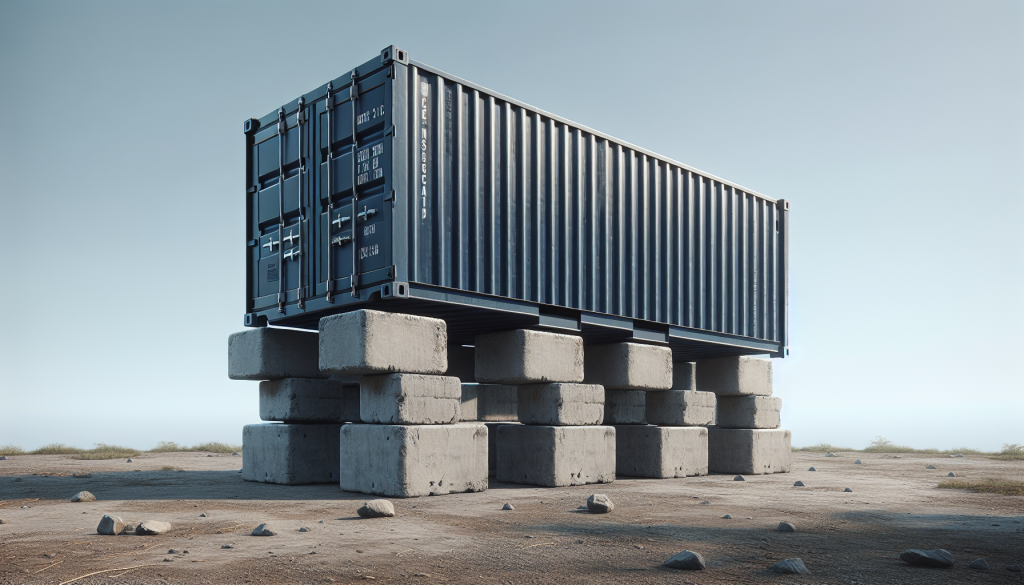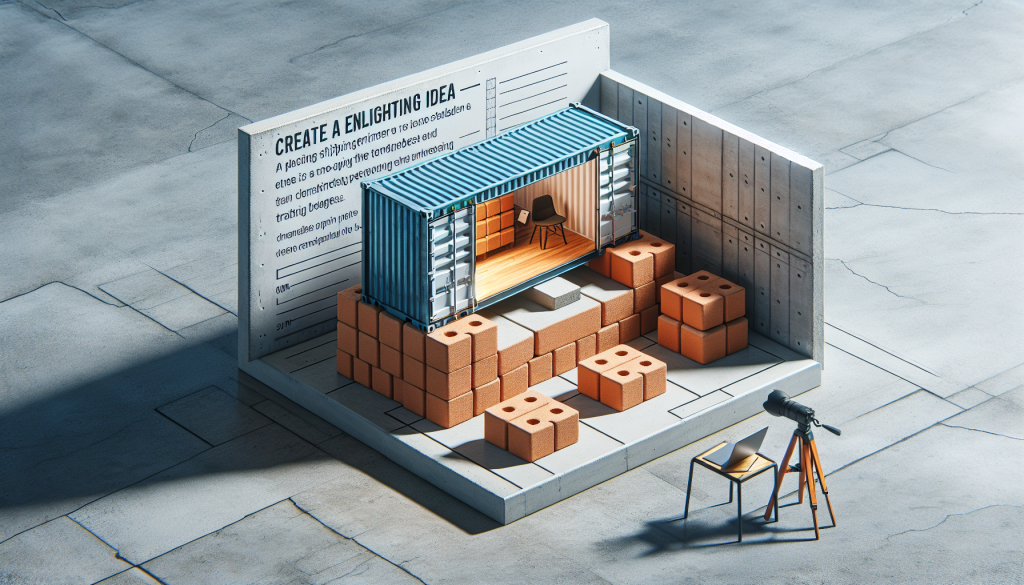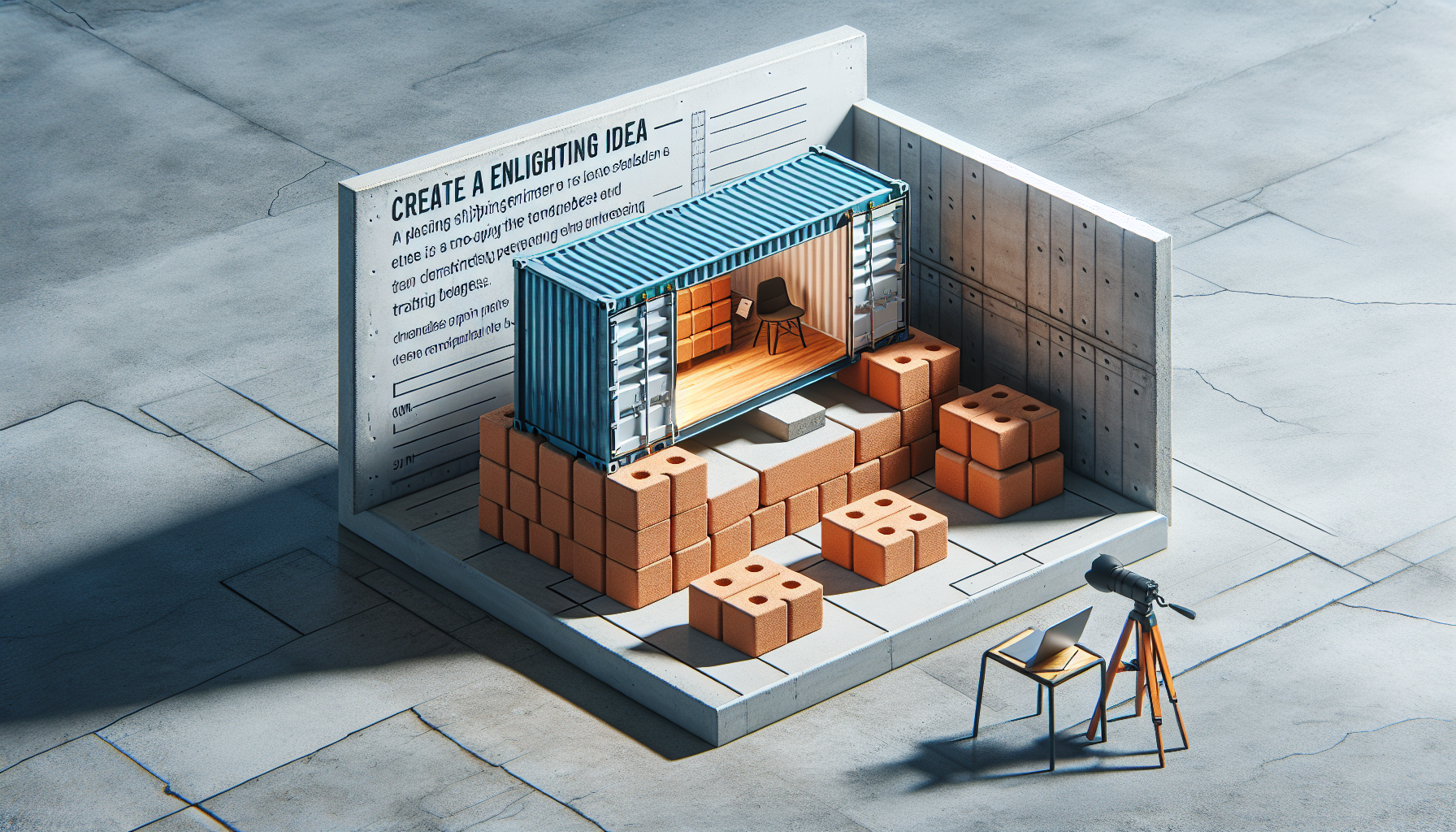Have you ever wondered if it’s possible to set a shipping container on cinder blocks? Well, we have the answer you’re looking for. In this article, we will explore whether it’s feasible to use cinder blocks as a foundation for a shipping container and discuss the potential advantages and disadvantages of this method. So, if you’re curious about alternative ways to set up a shipping container, keep reading to find out more!

1. The Basics of Shipping Containers
1.1 What are shipping containers?
Shipping containers are large, standardized steel boxes that are primarily used for transporting goods across long distances. They are designed to be durable, weatherproof, and easily stackable, making them ideal for transportation by ships, trains, and trucks. These containers typically have a rectangular shape and come in various sizes, including 20 feet, 40 feet, and even larger options.
1.2 Common uses of shipping containers
Shipping containers are not only limited to transporting goods. They have become increasingly popular for various other purposes, including storage units, temporary offices, and even housing solutions. Their versatility and modular nature allow for easy modification and customization, making them a viable option for a wide range of applications.
1.3 Characteristics of shipping containers
Shipping containers are designed with several key characteristics that make them suitable for their intended purposes. They are made from sturdy steel, which ensures durability and resistance to harsh weather conditions. Additionally, they have standardized dimensions, allowing for easy handling and transportation. The corners of shipping containers are reinforced to facilitate stacking and lifting, and they often have double doors at one end, making loading and unloading efficient.
2. Cinder Blocks and Their Uses
2.1 What are cinder blocks?
Cinder blocks, also known as concrete blocks or breeze blocks, are rectangular construction blocks made from a mixture of cement, aggregates, and water. They are hollow and usually have two or three voids running throughout, which significantly reduces their weight while maintaining structural stability. These blocks are commonly used in construction projects for walls, foundations, and as support structures.
2.2 Materials used in cinder blocks
The main materials used in the production of cinder blocks are cement, sand, and aggregates like gravel or crushed stones. These materials are mixed together with water to form a paste that is poured into molds and then cured. The curing process allows the mixture to harden and gain strength, resulting in solid and durable blocks.
2.3 Common uses of cinder blocks
Due to their affordability and versatility, cinder blocks have a wide range of applications in construction. They are commonly used to build walls, both exterior and interior, as well as retaining walls, barriers, and even outdoor furniture. Cinder blocks provide a cost-effective solution for creating structural elements and can easily be modified or repurposed to suit specific project requirements.
3. Can You Set a Shipping Container on Cinder Blocks?
3.1 The Safety Factor
Setting a shipping container on cinder blocks is a feasible option, but safety should always be the top priority. It is crucial to ensure that the cinder blocks and the foundation they are placed on can adequately support the weight and structural load of the shipping container. Consulting with a structural engineer or a professional experienced in this type of installation is highly recommended to ensure safety and compliance with local regulations.
3.2 Consideration of Weight and Structure
Shipping containers are significantly heavier than standard structures, and cinder blocks may not be sufficient on their own to support the weight. It is important to evaluate the load-bearing capacity of the cinder blocks and determine if additional reinforcement, such as concrete footings or steel beams, is necessary. The structure on which the cinder blocks are placed must also be strong enough to handle the weight distribution.
3.3 Leveling and Stability Issues
Proper leveling and stability are essential when setting a shipping container on cinder blocks. Uneven surfaces or unstable foundations can cause the container to shift or tilt, leading to potential structural damage or safety hazards. It is imperative to ensure that the cinder blocks are placed on a level surface and adequately secured to prevent any movement.
3.4 Impact on the Foundation
Setting a shipping container on cinder blocks can have an impact on the foundation underneath. The concentrated weight of the container may cause the ground to compress or settle, potentially affecting the stability of nearby structures or the overall integrity of the foundation. It is advisable to assess the foundation’s capacity and consult with professionals to determine any necessary reinforcement or modifications.
3.5 Effect of Weather Conditions
Weather conditions, such as heavy rains or freezing temperatures, can affect the stability and durability of the cinder blocks and the shipping container. Adequate drainage and waterproofing measures should be implemented to prevent moisture buildup, which can lead to corrosion and deterioration of materials. Additionally, insulation may be necessary to regulate temperature and prevent condensation inside the container.
3.6 Accessibility and Maintenance
Setting a shipping container on cinder blocks may affect the accessibility and maintenance of the container. It is important to consider how the container will be accessed, whether for loading and unloading or for regular maintenance tasks. Safety measures, such as stairs or ramps, should be incorporated to ensure ease of access, and regular inspections and maintenance should be carried out to identify any potential issues early on.
4. Installation Process
4.1 Site Preparation
Before setting a shipping container on cinder blocks, proper site preparation is essential. The ground should be cleared of any debris or vegetation, and the area should be leveled to ensure a stable foundation. It is advisable to consult with professionals or follow local building codes and regulations to determine specific requirements for the installation site.
4.2 Choosing the Right Cinder Blocks
Selecting the appropriate cinder blocks is crucial for a successful installation. The blocks used should have sufficient load-bearing capacity and be specifically designed for construction purposes. It is recommended to consult with experts or suppliers to ensure that the chosen cinder blocks meet the necessary standards and comply with local regulations.
4.3 Placing the Cinder Blocks
The cinder blocks should be placed in a grid pattern to evenly distribute the weight of the shipping container. Careful attention should be given to the alignment and leveling of each block to maintain stability. It may be necessary to use a level and shims to achieve proper alignment, ensuring that the blocks are securely positioned before placing the container.
4.4 Positioning the Shipping Container
Once the cinder blocks are properly set in place, the shipping container can be positioned on top. It is essential to align the container on the blocks and ensure that it is level. Depending on the size and weight of the container, some equipment, such as a crane or forklift, may be necessary for lifting and maneuvering.
4.5 Anchoring and Securing the Container
Anchoring and securing the shipping container to the cinder blocks is vital for stability and safety. Various methods can be employed, such as welding brackets or using bolts and straps. These measures ensure that the container remains securely attached to the cinder blocks and prevents any unwanted movement or shifting.

5. Advantages of Setting a Shipping Container on Cinder Blocks
5.1 Cost-Effectiveness
Using cinder blocks as a foundation for a shipping container can be a cost-effective solution compared to more traditional methods. Cinder blocks are readily available and relatively inexpensive, making them an attractive alternative for those on a budget. Additionally, the versatility of shipping containers allows for cost savings in terms of storage or accommodation solutions.
5.2 Ease and Speed of Installation
Setting a shipping container on cinder blocks offers a relatively straightforward and efficient installation process. Compared to traditional building methods, which involve extensive construction and preparation, the use of cinder blocks simplifies the process and reduces installation time. This can be especially advantageous for temporary structures or quick turnaround projects.
5.3 Flexibility and Portability
One of the key advantages of using shipping containers is their inherent flexibility and portability. By setting a container on cinder blocks, it becomes possible to relocate the structure if needed. This flexibility allows for easy reconfiguration or reuse of the container, making it a dynamic solution for changing requirements or varying project scopes.
5.4 Reduced Environmental Impact
Repurposing shipping containers and using cinder blocks as a foundation can contribute to reducing the environmental impact of construction projects. By recycling these materials, both waste and energy consumption associated with new construction can be minimized. Additionally, the modular nature of shipping containers allows for resource-efficient design and construction practices.
6. Potential Challenges and Considerations
6.1 Local Building Codes and Regulations
Before proceeding with setting a shipping container on cinder blocks, it is essential to research and understand the local building codes and regulations. These guidelines may dictate the specific requirements, such as the maximum height, setbacks, or permits necessary for the installation. Compliance with these rules is crucial to avoid any legal issues or safety concerns.
6.2 Structural Integrity and Durability
While shipping containers are designed to withstand the rigors of transportation, consideration should be given to their long-term structural integrity and durability. The use of cinder blocks as a foundation should be carefully assessed to ensure that it provides the necessary support and stability required for the container’s lifespan. Regular inspections are also recommended to identify any signs of wear or potential structural issues.
6.3 Insulation and Climate Control
Shipping containers are not inherently designed for insulation or climate control. When setting a container on cinder blocks, it is important to address these factors. Insulation materials, such as spray foam or rigid panels, can be applied to the container’s interior or exterior to improve thermal performance. Additionally, HVAC systems or other climate control measures may be necessary, depending on the intended use of the structure.
6.4 Moisture and Condensation Control
Moisture and condensation can be a challenge when using shipping containers, particularly in humid or cold climates. Adequate ventilation and insulation can help reduce the risk of moisture buildup and consequent mold or rust formation. Effective sealing of openings, such as doors and windows, is also necessary to minimize air leakage and reduce the potential for condensation.
6.5 Pest Control
Shipping containers, especially when placed on the ground, may attract pests such as rodents or insects. Proper pest control measures should be implemented to prevent infestations, particularly when using cinder blocks as a foundation. Sealants and screens can be applied to openings, and regular inspections should be conducted to identify and address any potential pest entry points.
6.6 Noise and Vibration
Shipping containers may transmit noise and vibration, particularly when used for certain activities or in shared environments. Depending on the intended use, additional soundproofing measures may be necessary to mitigate noise disturbances. Insulating the container’s walls, floors, and ceilings can help minimize noise transmission and enhance the comfort of the space.
7. Safety Precautions and Best Practices
7.1 Engage Professional Advice
When considering setting a shipping container on cinder blocks, it is strongly recommended to seek professional advice and assistance. Structural engineers, architects, or contractors experienced in container conversions can provide valuable insights and ensure that the installation meets safety standards and codes. Their expertise can help identify any potential risks or issues that may arise during the process.
7.2 Ensure Proper Leveling and Stabilization
Proper leveling and stabilization are crucial for the safe and secure installation of a shipping container on cinder blocks. The ground must be prepared adequately, and the blocks should be aligned and leveled to ensure the container remains stable. Failing to achieve proper leveling can result in structural instability, posing risks to the container and its occupants.
7.3 Conduct Regular Inspections
Regular inspections are important to identify and address any maintenance or structural issues promptly. Monitoring the condition of the cinder blocks, the container, and the overall installation ensures the longevity and safety of the structure. Any signs of damage, deterioration, or movement should be promptly addressed by professionals to prevent further complications.
7.4 Use Appropriate Anchoring Methods
Anchoring the shipping container to the cinder blocks is vital for stability, especially in areas prone to strong winds or seismic activity. Using appropriate anchoring methods, such as welding brackets or bolts and straps, ensures that the container remains securely attached to the blocks. These measures prevent any potential movement or dislodging that could lead to structural damage or safety hazards.
7.5 Maintain Adequate Ventilation
Proper ventilation is essential to prevent the buildup of moisture and improve air quality within the shipping container. Adequate ventilation systems should be installed, including vents, windows, or HVAC systems, depending on the project’s requirements. Regular maintenance and cleaning of ventilation openings are necessary to ensure their effectiveness and prevent blockages.
7.6 Familiarize Yourself with Local Regulations
To ensure compliance with local regulations, it is crucial to familiarize yourself with the specific rules and guidelines that apply to the installation of a shipping container on cinder blocks. This includes obtaining any necessary permits or approvals and adhering to height restrictions, setbacks from property lines, or other relevant requirements. Failure to comply with these regulations may result in legal consequences or forced removal of the structure.
8. Case Studies and Success Stories
8.1 DIY Projects with Cinder Blocks and Shipping Containers
Many DIY enthusiasts have successfully used cinder blocks as a foundation for their shipping container projects. From backyard sheds to off-grid cabins, these projects showcase the versatility and affordability of using shipping containers on cinder blocks. These DIYers often share their experiences, tips, and techniques online, providing a valuable resource for those interested in embarking on their own container conversion journey.
8.2 Commercial and Industrial Applications
The use of shipping containers on cinder blocks extends beyond DIY projects. Commercial and industrial sectors have embraced this innovative approach for various applications. Businesses have transformed containers into pop-up stores, mobile offices, or even modular construction sites. The speed and cost-effectiveness of utilizing shipping containers on cinder blocks have made them a popular choice for temporary or adaptive structures in these industries.
8.3 Innovative Designs and Creative Uses
Architects and designers continue to push the boundaries of container architecture, exploring innovative designs and creative uses for shipping containers on cinder blocks. From multi-story residential complexes to art installations, these projects not only demonstrate the aesthetic potential of containers but also emphasize their adaptability and sustainability in a rapidly evolving world. These notable designs inspire further exploration and creativity within the realm of container conversions.
9. Conclusion
9.1 Summary of Benefits and Considerations
Setting a shipping container on cinder blocks offers numerous benefits, including cost-effectiveness, ease of installation, flexibility, and reduced environmental impact. However, there are also important considerations to keep in mind, such as safety, compliance with regulations, and addressing potential challenges like structural integrity, insulation, moisture control, and pest management. Engaging professional advice, following best practices, and conducting regular inspections are crucial for a successful and safe container installation.
9.2 Final Thoughts
The combination of shipping containers and cinder blocks presents an exciting opportunity for creating versatile, affordable, and sustainable structures. Whether for personal or commercial use, the ability to repurpose shipping containers and utilize cinder blocks as a foundation offers endless possibilities. With proper planning, installation, and ongoing maintenance, setting a shipping container on cinder blocks can result in a functional and durable space that meets your unique needs and preferences.

I am James, the creator behind SeaBoxInnovations.com. Welcome to our premier online destination dedicated to the world of sea containers. Think Inside the Box is our tagline, and our website is your go-to source for exploring the endless potential of these versatile and adaptable containers. Whether you’re interested in purchasing, customizing, or learning about the latest trends in container architecture and design, we have you covered. Join us as we bridge the gap between traditional uses and cutting-edge applications, promoting sustainability and innovation in design and construction. Get ready to embark on your next big project with SeaBoxInnovations.com.

